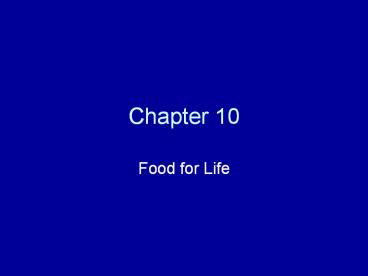Food for Life - PowerPoint PPT Presentation
1 / 13
Title: Food for Life
1
Chapter 10
- Food for Life
2
Food Facts
- 1 of Americans grow food for the rest
- 87 of food comes from 18 of the farms
- Most farms are factories owned by absentee
interests - All of the good land is already cultivated
- Intensification and genetic manipulation are
used as means to expand production - Farming uses 10x as much fossil fuel energy as it
returns in food energy
3
Soil
- 1/3 of original U.S. topsoil is gone being
eroded away much, much faster than being formed - Organic richness of soil is declining impairing
ability to cycle nutrients, fight disease,
maintain texture to protect roots hold water
4
Critical, but little known, factMost ancient
civilizations collapsed because they destroyed
their topsoil.
5
Agriculture and Water Quality
- Largest, most diffuse, most anonymous polluter
- Agricultural runoff
- Topsoil erosion, sediment
- Residues from over-application of chemical
fertilizers pesticides - Animal confinements
6
Issues of Genetics
- Our food coming from a very narrow genetic base
- Genetic diversity disappearing as native habitats
being destroyed - Unnatural monocultures create pest problems
- Seed banks are neglected
7
Sustainable Approaches Energy Efficiency
- Zero energy means to dry gain in silos
- Solar hot-air dryers for fruits, vegetables,
grains, herbs even lumber - Big, slow fans instead of small fast ones
- Change lighting in chicken houses
- Green building designs
- Passive-solar greenhouses
8
More Sustainable Approaches
- Produce food more locally to reduce
transportation energy - Substitute information for resources measure to
guide daily decisions - Close loops Reuse organic wastes as resources
(fuel, bio-based products, compost for nutrients)
9
Soil Microorganisms The Ultimate Loop-Closers
- Turn back into nutrient flows everything that
falls on or grows within the ground - Soil biology a vast growing mystery
- Many unknown ecological biochemical processes
at work - If soil-biota test kits were available to
farmers, they could count their wealth in
bacteria fungi rather than in acres bushels
10
Largest climatic impact Livestock
- Convert 2.2 - 20 lbs. of grain into 1 lb. of meat
- Beef averages 71 but can be much higher
- Fish, poultry pork more toward efficient end
- Solutions organic range beef, shift to other
meats, penalize inefficient production, tax
livestock methane
11
Nature as Model Mentor
- Ecologically-based grazing
- MIRG- management-intensive rotational grazing
- Biointensive minifarming
- Do nothing system of organic farming crops
that look after themselves - Integration of livestock with crops to recycle
nutrients
12
Natural Systems Agriculture
- Based on endurance, efficiency self-reliance of
wildness - Recognizes the inherent hardiness of plants in a
wild setting - Research based on prairie ecosystems
- No net soil erosion, no devastating pest
epidemics, no excess inputs, no wastes, recycles
all nutrients, conserves water, produces
abundantly, full of genetic information, it adapts
13
Dr. Wes Jackson at Land Institute in Salina,
Kansas
- Trying to replace annual monocultures with
perennial polycultures to form a diverse
ecosystem that looks like a native prairie (the
model) - Doesnt erode, soaks up rain, builds topsoil,
requires virtually no inputs - Farming may ultimately come to look as if nothing
at all is happening - No chemicals, no cultivation, no irrigation
- If there was a more efficient method of turning
sunlight into food, nature would have found it































